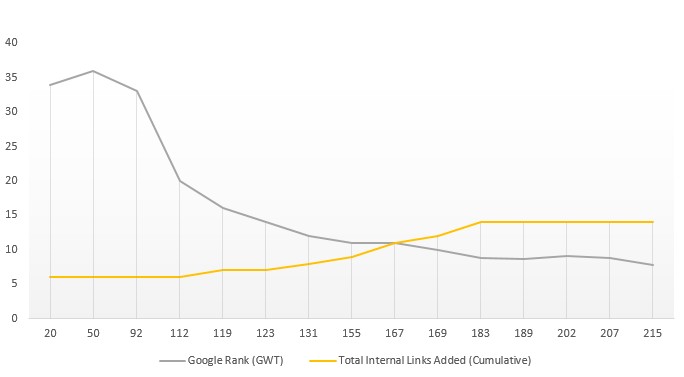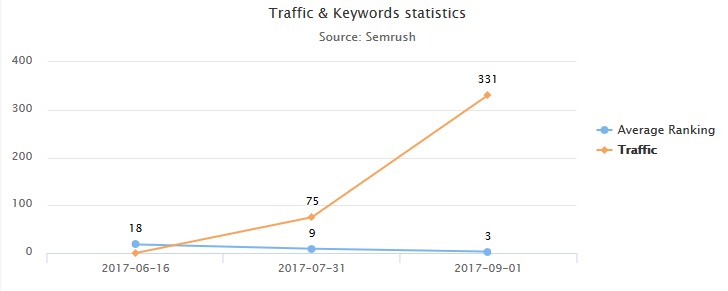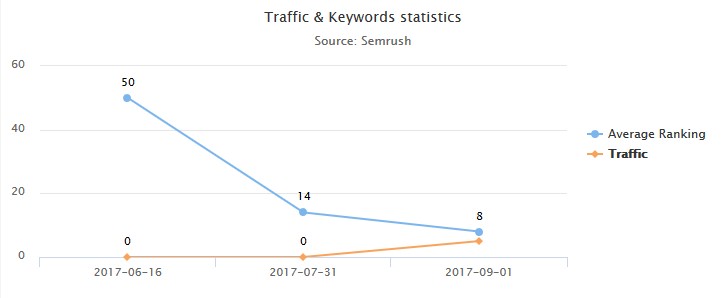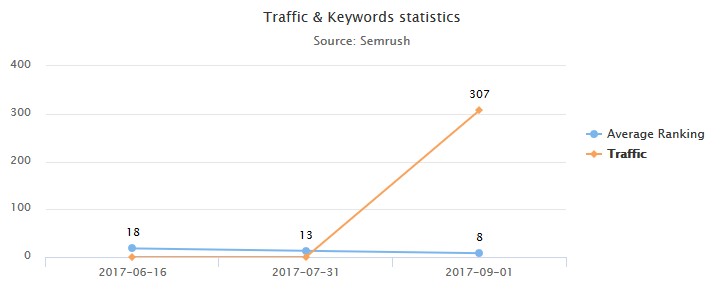Reaching the top 10 of Google without having to spend your days getting hypothetical backlinks is an attractive prospect. And achievable. Here are two experiments where the implementation of an internal network alone made it possible to obtain such a result.
The first is an independent experiment, initially published in English, and carried out in slow mode: the inlinks are added by hand, adding the links spanned 6 months, and the top 10 is reached in 169 days.
The second study was in French and created an automated implementation of the internal network, carried out with InLinks, where the top 10 was reached in 1 month (under necessarily different conditions)
1. Reach the Top 10 with manual linking, by Glenys Grob
This case study was produced and published by Glenys Grob on websitetips4u.com. You can find the entire study on his blog.
Based on the established principle that internal links allow both:
- to interconnect articles belonging to the same theme,
- allow search engines to crawl the content of a site better
- pass the SEO juice from page to page
- while being simpler to set up than external links 😉
Glenys Grob wanted to be able to measure the capacity of the internal links to rank a page until the content was top 10 of Google.
Objective: to beat high value (PR) pages
The site on which the study was conducted is an informative type of site. The keyword is of type “Product Name + Opinion” (Review in English), and the target page, the one that will be the recipient of the internal link network, offers a review on the product in question.
At the start of the experiment, the first 10 results of Google were occupied by 7 sites with a Page Rank equal to 7. The difficulty of the keyword was estimated at 29 out of 100.
Finally, the subject page of the study was already one year old and occupied position 39 on Google
Results achieved
As illustrated by the graph below (see raw data available on the original site), 14 links were implemented in 127 days, and the page went into the top 10 for the first time on the 152nd day, 5 months after the start of experimentation.
*The above data is correct as of May 20, 2020*
At the end of his article (see comments), Glenys notes the increase in the total number of keywords positioned on the target page. The experiment initially targeted only one keyword, but it appears that the establishment of the inlinks allowed the target page to position itself on many other keywords, called the long tail.
It is therefore more interesting to work on the ranking of the page, than on the keyword itself .
Apart from the inlinks, no other action was implemented, except the addition of an external link on the 189th day, when the target page had already reached the top 10.
2. Reach the Top 10 with automated inlinks
This case study was carried out on the entire site of one of our clients. We extracted several examples illustrating the impact of internal networking on the positioning of articles.
In contrast to the manual inlinks, the internal links were this time created and deployed using InLinks, with the following characteristics:
- Fully automated internal link generation
- Generation of internal links by Javascript (Google now happily crawls these)
- Deployment of 70% of links on day 1, then the remaining 30% over time
- Internal links are spread over 1,500 articles or approximately 640,000 words in total
It’s fine to use JavaScript to inject links into the DOM, as long as such links follow the guidelines for crawlable links.
Recently updated guidelines by Martin Splitz from Google here.
Objective: maximum ROI!
The site on which the study was conducted is a news site covering a new sector of activity very promising in the US. At the time of the test, it has a total of 4,500 articles (to be compared to the number of links created in the examples below).
The keywords selected for each target page (link recipient) are high-value keywords (1 to 2 words). The set of synonyms for each keyword was generated by InLinks. No manual intervention was carried out, apart from the keyword/page association, defined at the start.
Result # 1 – from 18th to 3rd place with 8 links – Difficulty: Very low
The first article benefited from 8 internal links. These 8 links being each of the sentence fragments, each link anchor was comprised of average 8 words (which is a rather high score for InLinks). The choice of articles on which to establish links was done in a 100% algorithmic way, according to the keyword and the context of each article.
The target article had no backlinks pointing to it. On the other hand, on the 8 articles at the origin of internal links, one of them had a backlink (from a site of weak authority).
The difficulty of the keyword is estimated at 0 by Ahrefs.
As illustrated by the graph below, the Google top 10 was reached 1.5 months after deployment of the internal links (the positions were checked on the Search Console)
*The above data is correct as of May 20, 2020*
Result # 2 – from 50th to 8th place with 48 links – Difficulty: Medium
The second target article benefited from 48 internal links. This article has about 500 words, it has no backlinks pointing to it .
On the other hand, 4 of the 48 articles linking to this article have a total of 26 backlinks .
The generation of the 48 links, fully automated, was made from 4 synonyms. The average length of text anchors is 2.5 words per link, ranging from 1 (exact match) to 12 words.
The difficulty of the keyword is finally estimated at 25 by Ahrefs, who considers it necessary to obtain backlinks from 29 different sites in order to rank this article in the top 10 of Google.
As illustrated by the graph below, the top 10 of Google was reached 2.5 months after deployment of the internal links (the positions were checked on the Search Console)
*The above data is correct as of May 20, 2020*
Result # 3 – from 18th to 8th place with 92 links – Difficulty: High
The third article benefited from 92 internal links. This article has fewer than 400 words and has no backlinks pointing to it.
On the other hand, 15 of the 92 articles linking to this article have a total of 46 backlinks .
The 92 links were automatically generated from 4 synonyms. The average length of text anchors is 3.7 words per link, ranging from 1 (exact match) to 15 words.
The keyword chosen corresponds to a central theme of the site. Its difficulty is 48 according to Ahrefs, who considers it necessary to obtain backlinks from 77 different sites in order to rank this article in the top 10 of Google.
As illustrated by the graph below, the Google top 10 was reached 2.5 months after deployment of the internal links (the positions were checked on the Search Console)
*The above data is correct as of May 20, 2020*
In conclusion…
These different case studies illustrate the importance of internal networking to improve the positioning of a page , whatever the difficulty of the chosen keyword. To deprive yourself of it is to shoot yourself without even noticing it, especially since it is an SEO factor on which you have all latitude of action.
The InLinks case studies must obviously be followed over time, but show a particularly interesting ROI, given the ease and speed of implementing the links; (approximately 5 minutes per page), to compare with the time necessary to achieve a similar internal link network by hand (how long would it take you to choose and modify links in 92 pages by hand…?





I think you need to push the homepage with tier-1 and tier-2 links for more serp increase. Anyway it is always feels good to read case studies regarding backlinks.
Sure – backlinks from other sites are of course a (generally positive) signal, but not something our tools tracks or manages.
What tool does inlink use for keywords difficulty and page rank as mentioned in the study?
The charts in this study used SEMRush. However, when that post was published in 2020, I do not know of any way to see Google’s Pagerank for any page and so I am not sure how Page Rank was mentioned.
Leave a Reply
Want to join the discussion?Feel free to contribute!